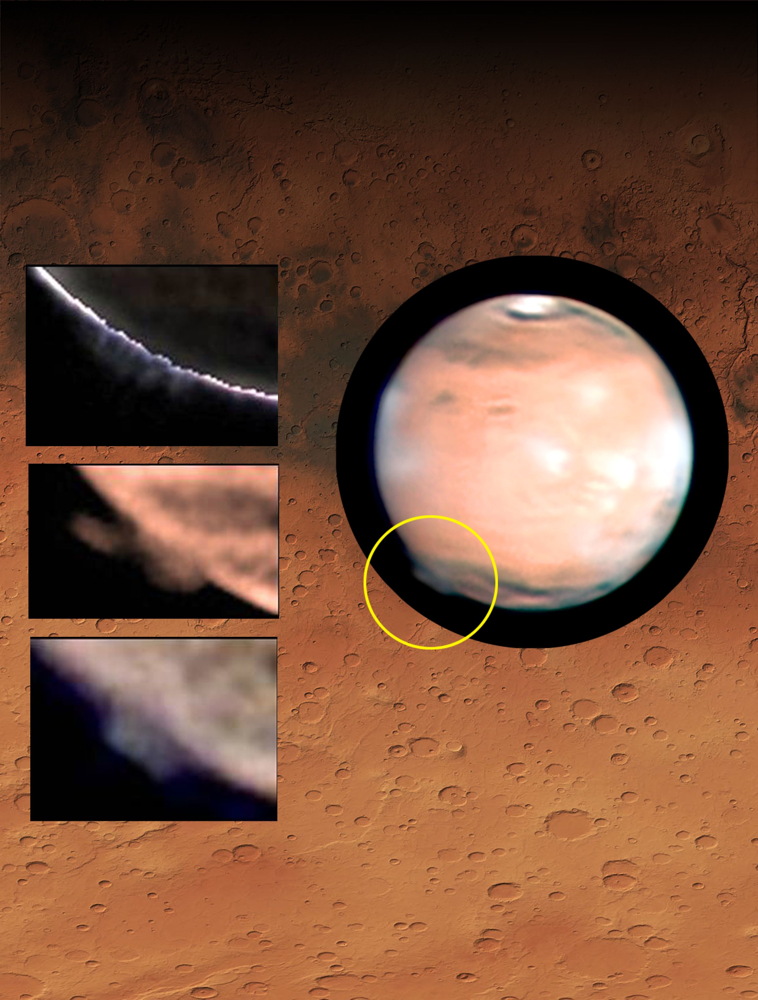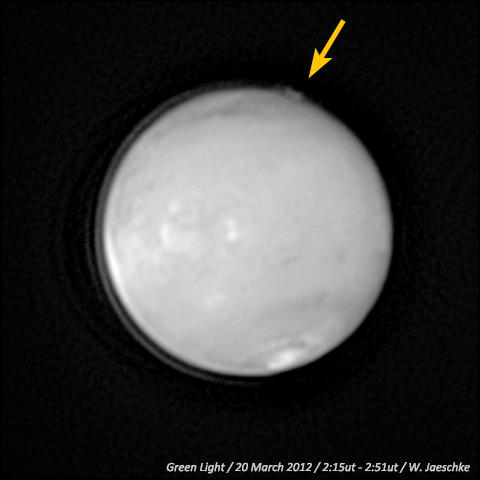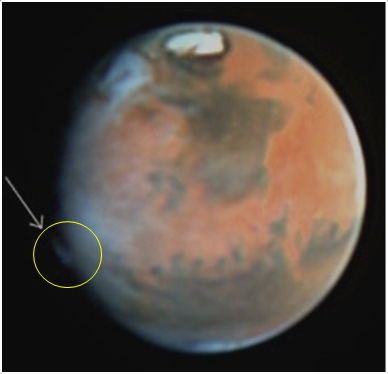Mysterious Plumes on Mars Have Scientists Stumped

A mystery is brewing on Mars: Amateur astronomers spotted enormous plumes erupting off the Red Planet's surface, leaving scientists puzzled.
More than 155 miles (250 kilometers) high and hundreds of miles across, the baffling plumes were spotted by amateur astronomers in the spring of 2012. The plumes reflect sunlight, which means they could be made of water ice, carbon dioxide ice or dust. But clouds made of those materials would be hard to explain with current models of the Martian atmosphere, scientists say.
Images of Mars from the last 20 years reveal that shorter plumes, reaching heights of about 62 miles (100 km), occasionally flare up from the planet's surface. An image by the Hubble Space Telescope from 1997 revealed another abnormally high plume, similar to the one seen in 2012, according to a statement from the European Space Agency (ESA). [7 Biggest Mysteries On Mars]
Scientists at the Universidad del Pais Vasco in Spain studied the images of the plumes and confirmed that they reach heights of more than 155 miles (250 km) above the surface, and cover an area of up to 310 by 620 miles (500 by 1,000 km).
"At about 250 km, the division between the atmosphere and outer space is very thin, so the reported plumes are extremely unexpected," says Agustín Sánchez-Lavega of the Universidad del País Vasco, lead author of the new research.
The features developed in less than 10 hours and remained visible for about 10 days, but changed their structure from day to day, ESA officials wrote in a statement. None of the spacecraft orbiting Mars were in a position to see the plumes, due to their locations around the planet and light conditions at the time.
Analysis of the images from 2012 and of past images of plumes erupting from the surface of Mars haven't helped the researchers determine what caused the plumes or what they are made of.
Breaking space news, the latest updates on rocket launches, skywatching events and more!
"One idea we've discussed is that the features are caused by a reflective cloud of water-ice, carbon dioxide-ice or dust particles, but this would require exceptional deviations from standard atmospheric circulation models to explain cloud formations at such high altitudes," Sánchez-Lavega said in a statement.
It's possible the plumes are somehow caused by Martian auroras, according to the authors of the new research. These brilliant light displays are known on Earth as the northern and southern lights, and are caused by the interaction of high- energy particles and a planet's magnetic field.
"Another idea is that they are related to an auroral emission, and indeed auroras have been previously observed at these locations, linked to a known region on the surface where there is a large anomaly in the crustal magnetic field," Antonio Garcia Muñoz, a research fellow at ESA's ESTEC and co-author of the study, said in a statement.
The ESA statement reports that "further insights should be possible following the arrival of ESA's ExoMars Trace Gas Orbiter at the Red Planet, scheduled for launch in 2016."
The new results were reported in yesterday's (Feb. 16) issue of the journal Nature.
Follow Calla Cofield @callacofield. Follow us @Spacedotcom, Facebook and Google+. Original article on Space.com.

Calla Cofield joined Space.com's crew in October 2014. She enjoys writing about black holes, exploding stars, ripples in space-time, science in comic books, and all the mysteries of the cosmos. Prior to joining Space.com Calla worked as a freelance writer, with her work appearing in APS News, Symmetry magazine, Scientific American, Nature News, Physics World, and others. From 2010 to 2014 she was a producer for The Physics Central Podcast. Previously, Calla worked at the American Museum of Natural History in New York City (hands down the best office building ever) and SLAC National Accelerator Laboratory in California. Calla studied physics at the University of Massachusetts, Amherst and is originally from Sandy, Utah. In 2018, Calla left Space.com to join NASA's Jet Propulsion Laboratory media team where she oversees astronomy, physics, exoplanets and the Cold Atom Lab mission. She has been underground at three of the largest particle accelerators in the world and would really like to know what the heck dark matter is. Contact Calla via: E-Mail – Twitter


